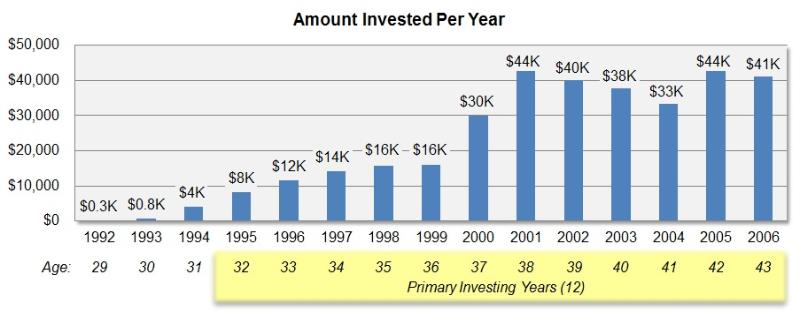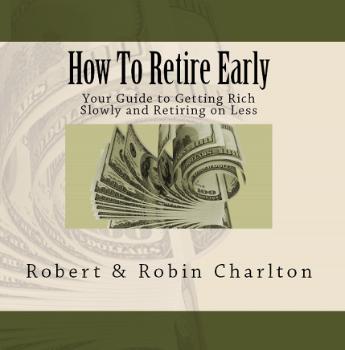

Early Retirement
| How Much Should You Invest Per Month to Retire Early? |
Percentage-wise, that comes out to about 33% of our net income on average
per year. So if you’re saving one-quarter to one-third of your net income, there
is a fair chance you’re on track for early retirement too.
Note the big jump in savings that occurred in 2000 and 2001 due to my wife’s
retraining as a nurse. After paying off her student loans in 2000, we were able
to channel virtually all of the extra money she was earning straight into
investments. The lesson learned is to invest in yourself first if you want to
maximize results.
We kept things simple by investing more or less equal amounts in three
Vanguard index funds: the Vanguard 500 Index Fund (VFINX), Vanguard
Extended Market Index Fund (VEXMX), and Vanguard Total International Stock
Index Fund (VGTSX). We were essentially 100% invested in stocks during our
primary investing years and only added a significant position in bonds upon
selling our home and retiring.
How Much Can YOU Invest Monthly?
What you can accomplish depends a lot on your own situation, of course,
financial and otherwise. Let’s take a look at three different scenarios:
The investing calculator at daveramsey.com (under the “Tools” tab) can be a
great help in testing out different what-if scenarios and monthly investment
amounts.
If all of these amounts seem impossibly large to you, don’t get discouraged:
just consider how little we saved in our first three years. With a long time
horizon, you have plenty of time to make career improvements to supercharge
your savings. Tip: When you get a raise at work, channel the majority of it into
increased savings before you become used to living on the higher amount.
Your monthly savings rate can jump dramatically by following this simple
approach.
Jobs and Kids
Retiring early does not demand a high-powered job but it does require you to
live consistently below your means. We achieved early retirement with no
outside financial help and with combined gross salaries averaging $89,000
over the 15 years from 1992 to 2006. Most people take comfort in hearing we
were able to realize our early retirement dreams with relatively normal jobs.
We can say with certainty we could not have retired at age 43 with kids given
our modest salaries, but we believe we could have retired by age 50. To give
yourself the best chance of success, let compounding do more of the work for
you by investing smaller amounts over a longer period of time. This will give
your investments (and your kids) more time to grow.
per year. So if you’re saving one-quarter to one-third of your net income, there
is a fair chance you’re on track for early retirement too.
Note the big jump in savings that occurred in 2000 and 2001 due to my wife’s
retraining as a nurse. After paying off her student loans in 2000, we were able
to channel virtually all of the extra money she was earning straight into
investments. The lesson learned is to invest in yourself first if you want to
maximize results.
We kept things simple by investing more or less equal amounts in three
Vanguard index funds: the Vanguard 500 Index Fund (VFINX), Vanguard
Extended Market Index Fund (VEXMX), and Vanguard Total International Stock
Index Fund (VGTSX). We were essentially 100% invested in stocks during our
primary investing years and only added a significant position in bonds upon
selling our home and retiring.
How Much Can YOU Invest Monthly?
What you can accomplish depends a lot on your own situation, of course,
financial and otherwise. Let’s take a look at three different scenarios:
- 15-year plan: Based on our own experience, about $24,000 per year or
$2,000 per month is a reasonable investment amount if you’re aiming for
retirement in 15 years. That amount -- plus compounding, plus any
equity if you own a home and are willing to downsize -- may be enough
to allow for a modest early retirement. In our own case, we were able to
downsize to a $100,000 condo once we retired, which let us channel the
other $200,000 from the sale of our home into Vanguard Total Bond
Market Index Fund (VBMFX).
- 20-year plan: The above goal is frankly over-ambitious for most parents.
We would suggest parents aim at saving $15,000 per year or $1,250
per month for 20 years to achieve a roughly similar nest egg result.
- 25-year plan: If you don’t want to scrimp and save quite so much,
another option is $9,000 per year or $750 per month for 25 years. The
power of compounding is such that smaller amounts saved over longer
periods of time can achieve surprisingly effective results.
The investing calculator at daveramsey.com (under the “Tools” tab) can be a
great help in testing out different what-if scenarios and monthly investment
amounts.
If all of these amounts seem impossibly large to you, don’t get discouraged:
just consider how little we saved in our first three years. With a long time
horizon, you have plenty of time to make career improvements to supercharge
your savings. Tip: When you get a raise at work, channel the majority of it into
increased savings before you become used to living on the higher amount.
Your monthly savings rate can jump dramatically by following this simple
approach.
Jobs and Kids
Retiring early does not demand a high-powered job but it does require you to
live consistently below your means. We achieved early retirement with no
outside financial help and with combined gross salaries averaging $89,000
over the 15 years from 1992 to 2006. Most people take comfort in hearing we
were able to realize our early retirement dreams with relatively normal jobs.
We can say with certainty we could not have retired at age 43 with kids given
our modest salaries, but we believe we could have retired by age 50. To give
yourself the best chance of success, let compounding do more of the work for
you by investing smaller amounts over a longer period of time. This will give
your investments (and your kids) more time to grow.
| Originally published in Motley Fool |

Nobody’s saying it’s easy to retire early on an average salary, but it’s not
impossible either. It took us 15 years to “get rich slowly,” investing steadily
month by month until we had amassed a nest egg of nearly $1 million --
enough to safely generate about $40,000 per year. We’ve been retired for
nearly ten years now and have found we can live comfortably if frugally on this
amount while still traveling extensively.
How Much We Invested Monthly
If you add up the total amount we invested over the 15 years from 1992 to
2006 (the year in which we retired), it comes to $342,000. This is the amount
we put in, not counting compounding due to market returns. That averages out
to $22,800 per year or $1,900 per month.
The first 3 years of this 15-year period were insignificant in terms of investing
because we were focused on buying and furnishing our home, paying off
loans, and switching to a 15-year mortgage. During our 12 primary investing
years we averaged just over $28,000 per year or $2,333 per month in
investments.
impossible either. It took us 15 years to “get rich slowly,” investing steadily
month by month until we had amassed a nest egg of nearly $1 million --
enough to safely generate about $40,000 per year. We’ve been retired for
nearly ten years now and have found we can live comfortably if frugally on this
amount while still traveling extensively.
How Much We Invested Monthly
If you add up the total amount we invested over the 15 years from 1992 to
2006 (the year in which we retired), it comes to $342,000. This is the amount
we put in, not counting compounding due to market returns. That averages out
to $22,800 per year or $1,900 per month.
The first 3 years of this 15-year period were insignificant in terms of investing
because we were focused on buying and furnishing our home, paying off
loans, and switching to a 15-year mortgage. During our 12 primary investing
years we averaged just over $28,000 per year or $2,333 per month in
investments.
